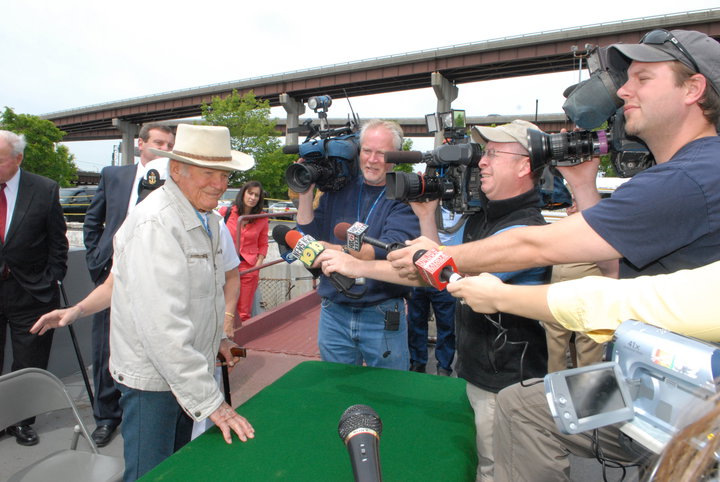His death was announced by Lt. Aaron Kakiel of the Navy, The Associated Press said.
On the morning of Sunday, Dec. 7, 1941, when Japanese planes bombed the American battleships in Hawaii, plunging the nation into World War II, numerous acts of valor played out. Most of them took place aboard the stricken ships — in some cases efforts by the wounded and the dying to save their fellow sailors. Amid the death and destruction, Chief Finn, on an airfield runway, was waging a war of his own against the Japanese.
A few minutes before 8 o’clock, Japanese planes attacked the Kaneohe Bay Naval Air Station, about 12 miles from Battleship Row at Ford Island, hoping to knock out three dozen Navy aircraft before they could get aloft.
Mr. Finn, the chief petty officer in charge of munitions at the naval station and a veteran of 15 years in the Navy, was in bed in a nearby apartment he shared with his wife, Alice. He heard the sound of aircraft, saw one plane flash past his window, then another, and he heard the firing of machine guns.
He dressed hurriedly, got into his 1938 Ford and drove to the naval station. At first, he observed the base’s 20 miles-per-hour speed limit. But then, “I heard a plane come roaring in from astern of me,” he recalled decades later in an interview with Larry Smith for “Beyond Glory,” an oral history of Medal of Honor recipients.
“As I glanced up, the guy made a wing-over, and I saw that big old red meatball, the rising sun insignia, on the underside of the wing. Well, I threw it into second and it’s a wonder I didn’t run over every sailor in the air station.”
When Chief Finn arrived at the hangars, many of the planes had already been hit. He recalled that he grabbed a .30-caliber machine gun on a makeshift tripod, carried it to an exposed area near a runway and began firing. For the next two and a half hours, he blazed away, although peppered by shrapnel as the Japanese planes strafed the runways with cannon fire.
As he remembered it: “I got shot in the left arm and shot in the left foot, broke the bone. I had shrapnel blows in my chest and belly and right elbow and right thumb. Some were just scratches. My scalp got cut, and everybody thought I was dying: Oh, Christ, the old chief had the top of his head knocked off! I had 28, 29 holes in me that were bleeding. I was walking around on one heel. I was barefooted on that coral dust. My left arm didn’t work. It was just a big ball hanging down.”
Chief Finn thought he had hit at least one plane, but he did not know whether he had brought it down. When the attack ended, he received first aid, then returned to await a possible second attack. He was hospitalized the following afternoon.
On Sept. 15, 1942, Chief Finn received the Medal of Honor from Adm. Chester W. Nimitz, commander in chief of the Pacific Fleet, in a ceremony aboard the carrier Enterprise at Pearl Harbor. Admiral Nimitz cited Chief Finn for his “magnificent courage in the face of almost certain death.”
John William Finn was born on July 23, 1909, in Los Angeles County, the son of a plumber. He dropped out of school to join the Navy at age 17.
He served stateside after he recovered from his Pearl Harbor wounds, became a lieutenant in 1944 and remained in military service until 1947. He later owned a cattle ranch in Pine Valley, Calif., about 45 miles east of San Diego.
His wife died in 1998. A listing of survivors was not immediately available.
Ten of the 15 servicemen who received the Medal of Honor for their actions at Pearl Harbor died in the attack. Among them were Rear Adm. Isaac C. Kidd, commander of Battleship Division 1, who was aboard the Arizona when it blew up and sank; Capt. Franklin Van Valkenburgh, commander of the Arizona; and Capt. Mervyn S. Bennion, commander of the battleship West Virginia.
Four of the Pearl Harbor medal recipients survived the war. Cmdr. Cassin Young, awarded the medal for reboarding and saving his repair ship, the Vestal, after being blown into the water, died in November 1942 in the battle for Guadalcanal.
In 1999, Mr. Finn was among Pearl Harbor veterans invited to Hawaii for the premiere of the Hollywood movie “Pearl Harbor.” “It was a damned good movie,” he told The Boston Herald in 2001. “It’s helped educate people who didn’t know about Pearl Harbor and what happened there.”
“I liked it especially,” he said, “because I got to kiss all those pretty little movie actresses.”
Original link: http://www.nytimes.com/2010/05/28/us/28finn.html
Here is a link to his 100th Birthday party aboard the USS Slater in Albany in July 2009:
http://www.youtube.com/watch?v=ON0FkcUkpU4
Here is a picture of him on the USS Slater in July 2009.
